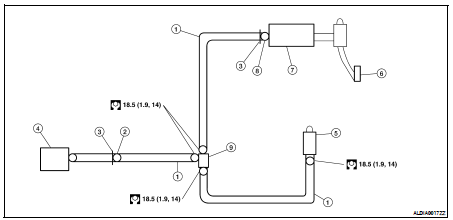Nissan Altima (L32) 2007-2012 Service Manual: Clutch piping
Exploded View
1. Clutch tube
2. CSC connector
3. Lock pin
4. CSC
5. Air bleed connector valve
6. Clutch pedal
7. Clutch master cylinder
8. Clutch master cylinder connector
9. Branch connector
Removal and Installation
CAUTION:
Do not spill clutch fluid onto painted surfaces. If it spills, wipe up
immediately and wash the affected
area with water.
REMOVAL
1. Remove the air cleaner and air duct. Refer to EM-19, "Removal and
Installation" for QR25DE and EM-
123, "Removal and Installation" for VQ35DE.
2. Remove the lock pin and disconnect the clutch master cylinder connector.
3. Remove the clutch tubes from the branch connector.
4. Remove the clutch tube and air bleed connector valve.
5. Remove the branch connector.
6. Remove lock pin and disconnect the CSC connector.
INSTALLATION
Installation is in the reverse order of removal.
• Make sure that all tubes are fully installed into connectors.
• Make sure that all connector lock pins are fully installed.
• After installation, bleed clutch hydraulic system. Refer to CL-7, "Air
Bleeding Procedure".
Removal and Installation
REMOVAL
1. Remove the air cleaner and air duct. Refer to EM-19, "Removal and
Installation" for QR25DE and EM-
123, "Removal and Installation" for VQ35 ...
Other materials: Corrosion protection
Most common factors contributing to
vehicle corrosion
Most vehicle corrosion is caused by:
The accumulation of moisture-retaining
dirt and debris in body panel sections,
cavities, and other areas.
Damage to paint and other protective
coatings caused by gravel and stone
chips or minor traffic ...
LED Daytime Running Lights (DRL)
system
The LED DRL automatically illuminate at
100% intensity when the engine is started
and the parking brake released. The LED
Daytime Running Lights (DRL) operate with
the headlight switch in any position. When
you turn the headlight switch to the
position for full illumination, the LED DRL
illuminate ...
Engine cooling system
The engine cooling system is filled at the
factory with a pre-diluted mixture of 50%
Genuine NISSAN Long Life Antifreeze/
Coolant (blue) and 50% water to provide
year-round antifreeze and coolant protection.
The antifreeze solution contains rust
and corrosion inhibitors. Additional engine
cooling s ...


 Clutch master cylinder
Clutch master cylinder Removal and installation
Removal and installation